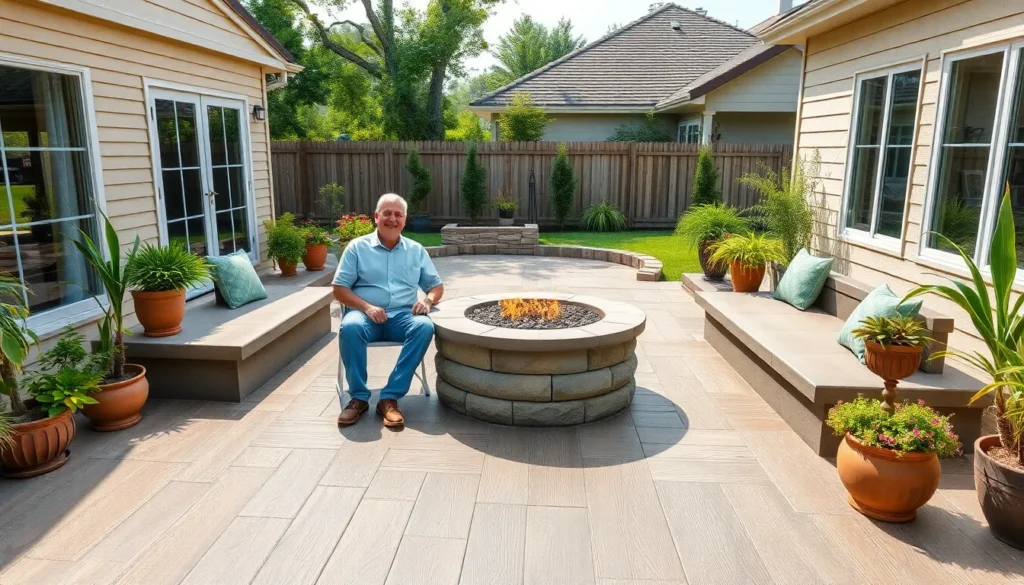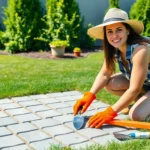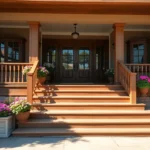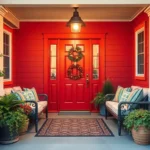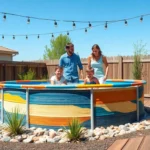We’ve all dreamed of that perfect outdoor space where we can unwind after long days and entertain friends on weekends. A well-designed cement patio transforms any backyard into a stunning retreat that’s both functional and beautiful. The best part? Concrete offers endless possibilities for customization while staying budget-friendly.
Cement patios aren’t just gray slabs anymore. Today’s options include stamped patterns that mimic natural stone decorative stains in rich colors and textured finishes that add visual interest. Whether you’re working with a small urban space or sprawling suburban yard we’ll show you how to create an outdoor oasis that reflects your personal style.
From sleek modern designs to rustic charm we’re sharing innovative ideas that’ll make your neighbors take notice. These concrete patio concepts prove that affordable doesn’t mean boring – and with proper planning your new outdoor space will become the heart of your home’s entertainment area.
Stamped Concrete Patio Designs That Mimic Natural Materials
Stamped concrete technology allows us to achieve the look of expensive natural materials at a fraction of the cost. We can create stunning outdoor spaces that fool the eye while providing the durability and low maintenance benefits of concrete.
Wood Plank Patterns for Rustic Appeal
Wood grain stamping transforms ordinary concrete into convincing timber flooring that withstands weather extremes. We recommend ashlar slate and boardwalk patterns for patios that capture the warmth of reclaimed barn wood or weathered deck planking. Popular wood stamp designs include cedar shake, rough sawn lumber, and hand hewn timber textures.
Staining options enhance the wood illusion with rich browns, honey tones, and gray weathered finishes. We often layer multiple stain colors to create authentic wood grain variations that develop character over time. Scoring techniques add realistic plank separation lines that complete the wooden deck appearance.
Maintenance requirements stay minimal compared to actual wood decking since stamped concrete resists rot, insects, and splintering. We seal these surfaces every 2-3 years to preserve color vibrancy and protect against moisture penetration.
Stone and Brick Textures for Classic Elegance
Fieldstone and cobblestone patterns create timeless patio surfaces that complement traditional architecture styles. We achieve natural stone textures through rubber mats that imprint realistic rock faces, mortar joints, and irregular edges into wet concrete. Flagstone stamps produce large format stones with organic shapes and varied surface textures.
Brick stamping offers versatility with running bond, herringbone, and basket weave layouts that suit both formal and casual outdoor settings. We enhance these patterns with earth tone stains in terracotta, burgundy, and charcoal that mimic fired clay authenticity. Antiquing release agents add depth by highlighting raised areas while darkening recessed joints.
Color combinations work best when we select 2-3 complementary hues that occur naturally in stone formations. Integral color provides base tones while surface stains create realistic variations and aging effects.
Geometric Patterns for Modern Sophistication
Contemporary stamp designs feature clean lines and repetitive motifs that align with modern architectural elements. We create striking patios using hexagonal tiles, diamond grids, and interlocking pavers that emphasize geometric precision. Large format rectangular stamps produce sleek surfaces reminiscent of oversized porcelain tiles.
Monochromatic color schemes work exceptionally well with geometric patterns since they emphasize form over texture. We often choose charcoal gray, crisp white, or warm beige integral colors that maintain visual consistency across the entire patio surface. Subtle color variations prevent monotony while preserving the sophisticated aesthetic.
Border integration helps define spaces and adds visual interest to geometric layouts. We incorporate contrasting stamps or accent colors along patio edges to create frames that enhance the overall design composition.
Colored Concrete Patio Ideas to Transform Your Space
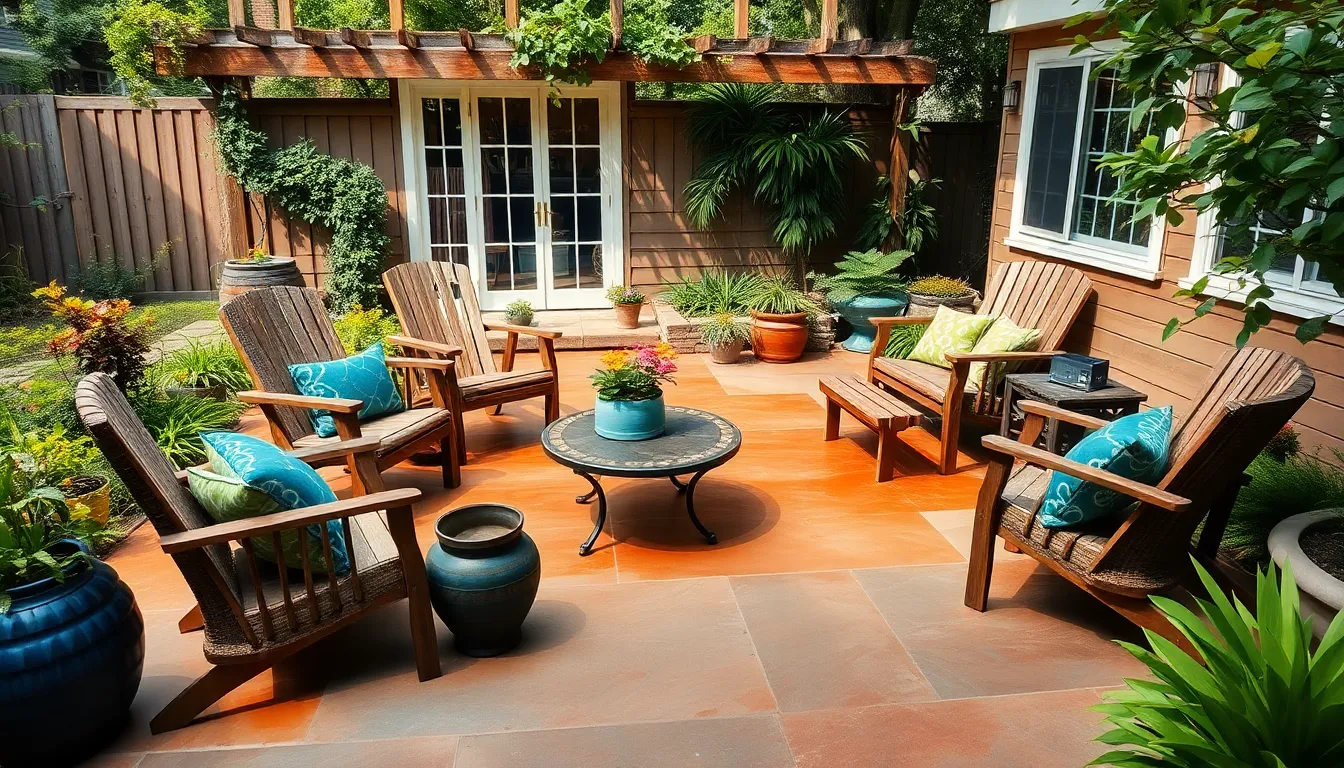
Moving beyond patterns and textures, we’ll explore how color can revolutionize your concrete patio’s appearance and create the perfect outdoor atmosphere.
Earth Tone Stains for Natural Harmony
Warm earth tones create a seamless connection between your patio and surrounding industry. These natural hues include rich browns, sandy beiges, terracotta oranges, and deep ochres that mimic soil, stone, and weathered wood. We’ve found that earth tone stains work exceptionally well for homeowners seeking a rustic or modern rustic aesthetic.
Blending capabilities make earth tones incredibly versatile for various design styles. Warm colors complement wooden outdoor furniture, natural stone planters, and lush greenery to create a cozy retreat atmosphere. Application techniques allow us to achieve subtle variations within the same color family, preventing the flat appearance that solid colors sometimes create.
Maintenance requirements for earth tone stains remain minimal while delivering maximum visual impact. These muted colors hide dirt and wear patterns better than lighter alternatives, making them practical choices for high traffic areas. We recommend earth tones for patios that need to harmonize with existing natural landscaping elements.
Bold Accent Colors for Statement Patios
Vibrant accent colors energize outdoor spaces and create dramatic focal points within your backyard design. Bold options include deep blues, rich reds, emerald greens, and sunset oranges that command attention and express personality. We apply these striking hues strategically rather than covering entire patio surfaces.
Strategic placement techniques maximize the impact of bold accent colors without overwhelming the space. Geometric shapes, decorative borders, and designated sections work well for incorporating vibrant colors into concrete patios. These applications create visual interest while maintaining balance with neutral base tones.
Contrast methods help bold colors define different functional areas within your outdoor living space. We use accent colors to highlight dining zones, seating areas, or pathways that guide foot traffic. Ever-changing color combinations allow homeowners to showcase their personal style while creating organized, purposeful outdoor environments.
Multi-Color Blending Techniques
Advanced blending methods combine multiple stains and pigments to produce varied, ever-changing concrete surfaces. These sophisticated techniques include marbling effects, ombré gradients, and patterns that replicate natural stone or decorative area rugs. We achieve these complex looks through careful application timing and specialized tools.
Zone definition becomes possible when we use multi-color blending to differentiate patio areas. Dining spaces might feature warmer tones while lounging areas incorporate cooler hues, creating natural boundaries without physical barriers. These color transitions guide the eye and enhance the functionality of different outdoor spaces.
Customization opportunities expand dramatically with multi-color applications that complement overall garden design. Intricate patterns can echo architectural details, industry features, or interior design elements to create cohesive outdoor living areas. We work with homeowners to develop color schemes that reflect their personal preferences while improving their property’s aesthetic appeal.
Decorative Concrete Border and Edging Concepts
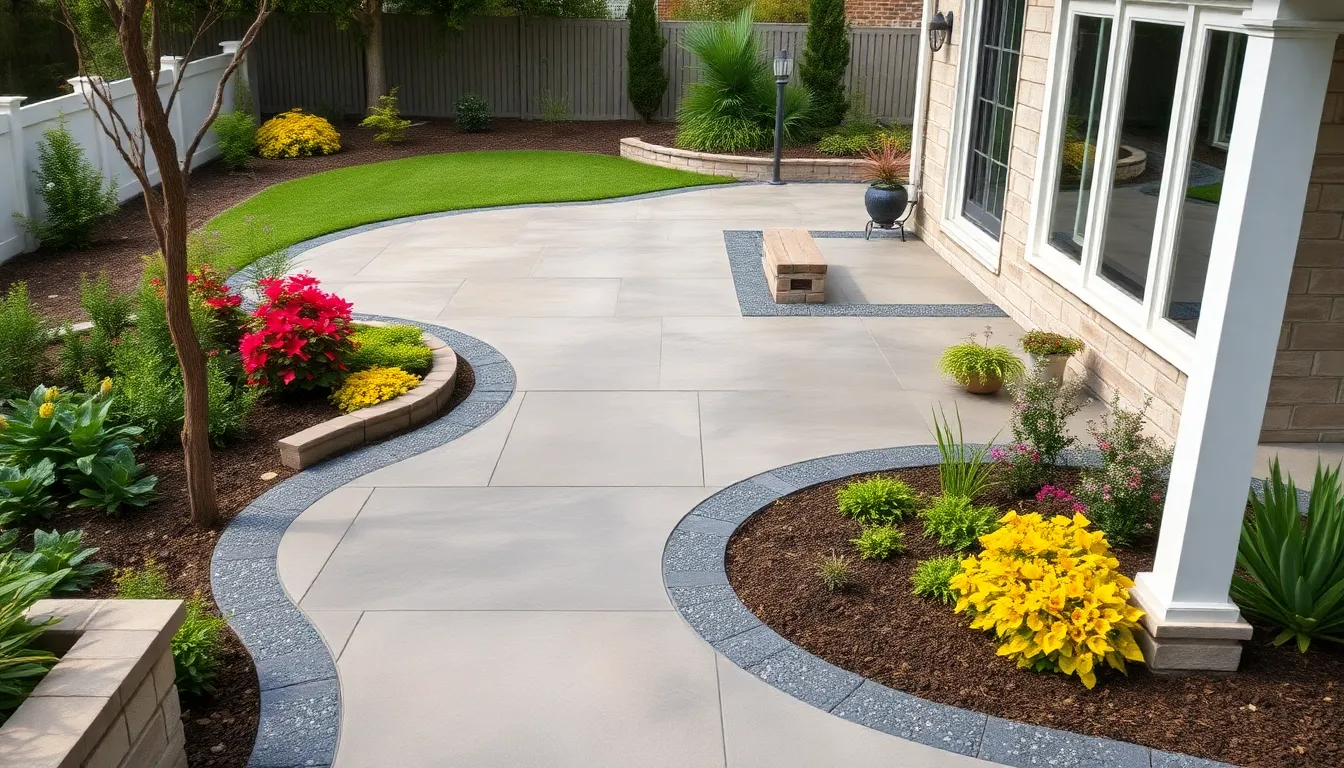
Borders and edging transform ordinary cement patios into defined outdoor spaces with architectural appeal. Well-designed borders create clear separation between patio areas and surrounding landscapes while adding visual structure to your backyard design.
Contrasting Color Borders for Definition
Colored concrete borders provide striking contrast that highlights your patio’s shape and creates distinct zones. We recommend using concrete dyes or stains to achieve a wide range of hues, from earthy tones like rich browns and sandy beiges that blend naturally with garden elements to bold accent colors that serve as focal points.
Solid contrasting strips work effectively to frame patio areas and visually separate them from adjoining lawn or garden beds. Intricate patterns offer another approach, allowing you to create detailed designs that complement your home’s architectural style. These colored borders can follow curved lines for organic flow or straight edges for contemporary appeal.
Staining techniques allow us to customize border colors to match seasonal plantings or coordinate with outdoor furniture. Earth tone borders require minimal maintenance while providing timeless appeal that works with various landscaping styles.
Textured Edge Treatments
Exposed aggregate finishes on border edges deliver both functionality and natural beauty. This popular option reveals stones or pebbles within the concrete, creating slip resistant surfaces ideal for poolside patios or areas requiring extra traction.
Stamped concrete borders can mimic natural materials like stone, wood grain, or brick patterns. These textured treatments complement different backyard aesthetics, from modern minimalist designs to rustic country styles. Broom finishes provide another texturing option that creates subtle linear patterns while improving surface grip.
Textured edges add depth and character to cement patios by contrasting smooth interior surfaces with detailed perimeter treatments. We often combine multiple textures within a single border design to create visual hierarchy and interest.
Integrated Planter Borders
Built in planter borders combine hardscape durability with softscape beauty. These concrete planters create raised planting beds along patio edges that visually soften the transition between hard surfaces and natural elements.
Curved planter designs flow organically around patio perimeters, while angular versions complement geometric patio layouts. We can enhance these planters with decorative concrete finishes or staining that coordinates with the main patio surface.
Integration with seating walls or fire features transforms planter borders into multifunctional elements. These combinations create outdoor retreat areas that serve multiple purposes while maintaining design cohesion throughout your backyard space.
Concrete Patio Layout Ideas for Different Backyard Sizes
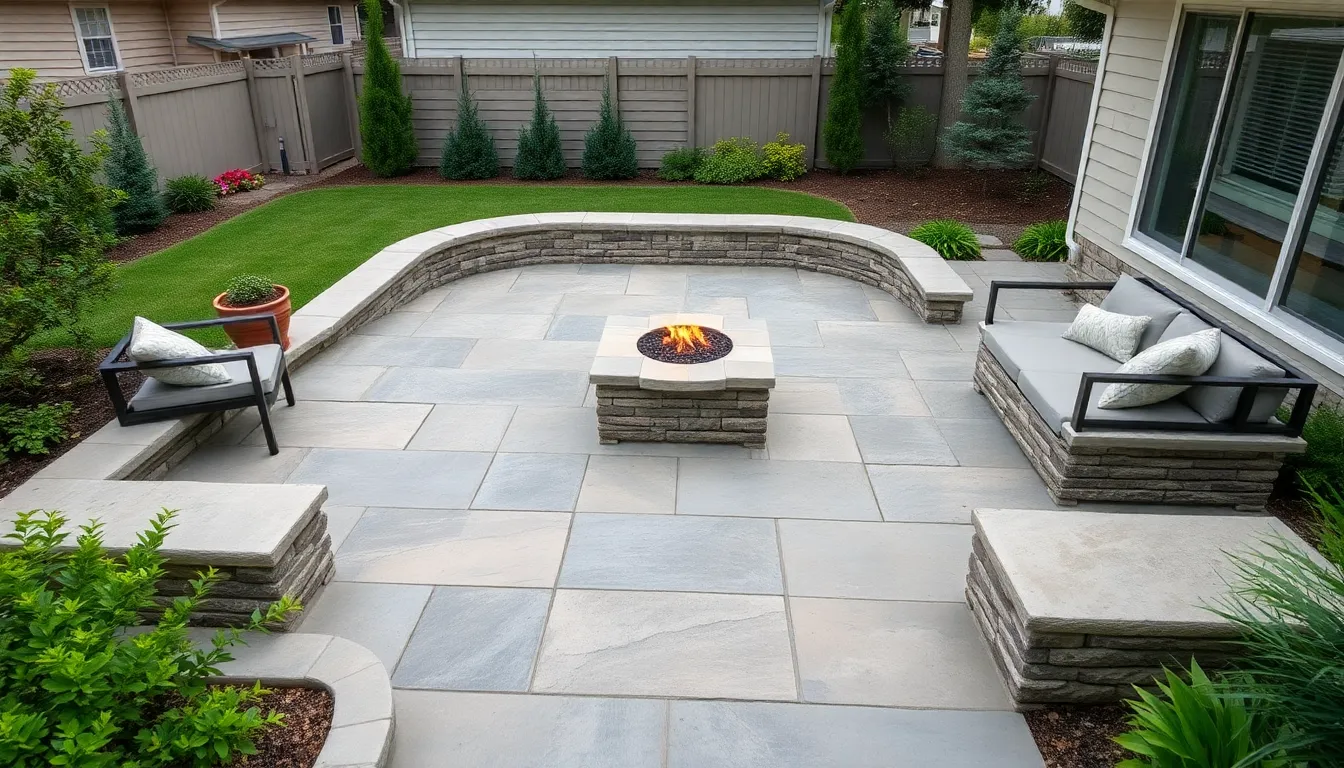
Layout selection significantly impacts how effectively your concrete patio functions within your available outdoor space. Strategic design choices maximize both visual appeal and practical use regardless of your backyard’s dimensions.
Compact Patio Designs for Small Spaces
Efficient layouts transform limited square footage into functional outdoor entertainment areas. Simple rectangular or square configurations work best for small backyards, creating clean lines that don’t overwhelm the space. Minimalist approaches focus on essential elements like seating and dining zones without unnecessary decorative features that could crowd the area.
Stamping techniques add visual interest without consuming precious space. Popular patterns like slate or flagstone textures create depth and character while maintaining the compact footprint. Curved corners soften harsh edges and make small patios feel more spacious than angular designs.
Built-in features maximize functionality within constrained areas. Integrated seating eliminates the need for separate patio furniture that could block pathways. Fire bowls or compact fire features create focal points while providing warmth for evening gatherings. L-shaped configurations define exact zones for cooking and relaxing while maintaining an open feel.
Expansive Multi-Level Concrete Terraces
Large backyards accommodate sophisticated multi-tiered patio systems that create distinct functional zones. Upper levels typically serve as dining areas with commanding views of the industry below. Lower terraces provide space for lounging furniture, fire pits, or outdoor kitchens that benefit from proximity to the house.
Natural contours guide terrace placement for optimal integration with existing industry features. Free-form shapes follow the yard’s natural slope rather than fighting against it with rigid geometric patterns. Retaining walls connect different levels while providing additional seating or planting opportunities.
Steps between levels create architectural interest and improve traffic flow throughout the outdoor space. Wide step treads can double as casual seating during larger gatherings. Curved or angled transitions between terraces add visual movement and prevent the design from appearing too rigid or institutional.
L-Shaped and Curved Patio Configurations
Angular L-shaped designs efficiently use corner spaces while creating natural separation between activity zones. One arm of the L typically accommodates dining furniture while the perpendicular section provides lounging space. Corner areas often house fire features or decorative elements that serve as transition points between the two functional areas.
Curved borders create smoother transitions between hardscape and softscape elements. Flowing lines complement garden beds and lawn areas better than straight edges that can appear harsh against natural plantings. Gradual curves also guide foot traffic naturally around the patio perimeter.
Strategic shape selection enhances the relationship between indoor and outdoor living spaces. L-shaped patios can wrap around building corners, extending the home’s footprint into the industry. Curved configurations soften the transition from interior spaces to garden areas, creating a more integrated outdoor living experience that feels like a natural extension of the home.
Aggregate Concrete Finishes for Added Visual Interest

After exploring layout options and border designs, we can elevate our cement patio’s visual appeal through aggregate concrete finishes. These specialized techniques transform ordinary concrete surfaces into textured masterpieces that combine functionality with stunning aesthetics.
Exposed Aggregate for Texture and Grip
Exposed aggregate creates dramatic visual interest by revealing the natural beauty hidden within concrete. We achieve this finish by removing the top layer of cement paste, exposing decorative stones, pebbles, or shells embedded throughout the surface. This technique delivers exceptional slip resistance, making it perfect for pool areas and high traffic zones where safety matters most.
Texture variations range from sleek contemporary to rugged natural appearances depending on our aggregate selection. Smooth river rocks create refined elegance, while crushed granite offers bold industrial appeal. We can customize the exposed depth to control how prominent the aggregate appears, allowing subtle textures for formal settings or dramatic reveals for statement patios.
Installation timing proves critical for achieving optimal results with exposed aggregate finishes. Surface preparation begins immediately after concrete placement, using specialized chemical retardants or power washing techniques to remove surface cement without disturbing the aggregate below.
Seeded Aggregate with Decorative Stones
Seeded aggregate allows precise control over decorative stone placement and pattern creation. We embed carefully selected pebbles, colored glass, or decorative stones into fresh concrete surfaces before they fully set. This method enables intricate designs, logos, or geometric patterns that standard exposed aggregate cannot achieve.
Color coordination becomes effortless when we select stones that complement our existing industry palette. Warm earth tones like amber and copper create cohesive transitions to natural plantings, while cool blues and grays provide sophisticated contrast against neutral hardscaping elements.
Pattern possibilities expand dramatically with seeded aggregate applications. We can create border designs, medallions, or even incorporate family crests or business logos directly into the concrete surface. Strategic stone placement allows zone definition within larger patio areas, visually separating dining spaces from lounging areas.
Polished Aggregate for Smooth Elegance
Polished aggregate delivers luxury appeal through mechanical grinding and chemical treatments that create mirror like finishes. We start with exposed aggregate surfaces, then progressively polish using diamond grinding pads until achieving the desired sheen level. This process transforms rugged textured concrete into sophisticated architectural elements.
Maintenance requirements decrease significantly with polished aggregate compared to traditional concrete sealers. The dense, non porous surface resists staining from wine spills, grease marks, and organic debris that typically plague outdoor entertaining areas. Regular sweeping and occasional mopping maintain the lustrous appearance year round.
Light reflection properties enhance outdoor ambiance during evening gatherings. Polished surfaces bounce artificial lighting and moonlight throughout the patio space, creating ever-changing visual effects that standard concrete cannot match. We often incorporate LED strip lighting around polished aggregate borders to maximize this dramatic effect.
Concrete Patio Extension and Connection Ideas
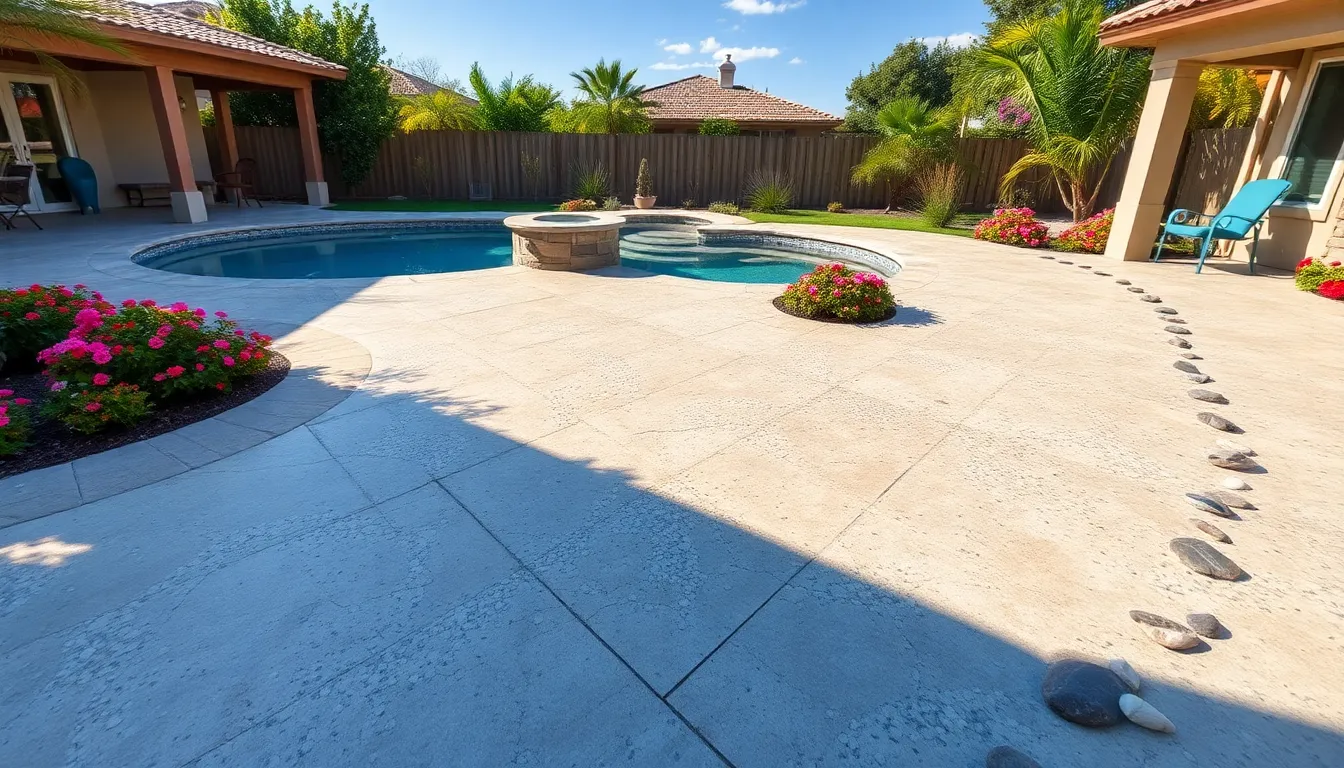
Building on the foundation of beautiful concrete patio designs, we can expand our outdoor living spaces by connecting different areas and extending existing structures for enhanced functionality.
Connecting Patios to Pool Areas
Seamless integration between patios and pool areas creates a cohesive outdoor entertainment zone that flows naturally throughout your backyard. Exposed aggregate concrete works exceptionally well for pool connections because it reveals natural stones or shells that provide a textured, slip-resistant surface around water areas. We recommend using consistent materials and finishes to create visual harmony between your patio and pool deck.
Stained or colored concrete adds vibrant or earthy tones that complement pool environments perfectly. Choose blues and greens for a water-inspired theme, or opt for warm terra cottas and sandy beiges to create a resort-like atmosphere. Curved concrete borders help separate pool decks from planting beds while maintaining smooth transitions between different zones.
Straight concrete borders offer a more contemporary approach to pool area connections. These clean lines enhance safety around water while creating defined spaces for lounging and dining. The key lies in selecting finishes that match your patio’s existing texture while providing the necessary slip resistance for wet conditions.
Extending Patios from Existing Structures
Extending patios from homes or existing outdoor structures requires careful planning to ensure natural flow and visual continuity. Concrete’s durability and versatility make it an ideal choice for patio extensions that need to withstand heavy foot traffic and weather exposure. We suggest using matching concrete finishes or complementary textures that blend seamlessly with your existing structure.
Decorative concrete techniques like staining, coloring, or stamping allow new sections to either blend with or accent existing patios. Consider using the same stamped pattern but in a slightly different color to create subtle definition between old and new areas. This approach maintains cohesion while acknowledging the extension as a distinct space.
Built-in features enhance both functionality and aesthetic appeal when extending patios. Concrete benches, fire pits, or planters can be integrated directly into the extension design, creating a modern rustic or urban look depending on your chosen style. These elements help the extension feel intentional rather than like an afterthought.
Creating Pathways Between Outdoor Spaces
Concrete pathways effectively link various backyard zones including patios, gardens, and pool areas while providing a long-lasting, low-maintenance solution. These connections can be straight for formal layouts or curved for more organic garden designs. The pathway width should accommodate comfortable two-person walking while fitting proportionally within your industry.
Decorative borders define pathway edges and create visual interest throughout your yard. Embedded patterns using contrasting aggregates or stamped designs help pathways complement surrounding landscaping. We often incorporate artistic elements like intricate staining or exposed aggregate to unify the yard’s overall design theme.
Separate outdoor rooms emerge naturally when pathways are designed with intentional transitions between spaces. Consider varying the pathway width at different points to create natural stopping areas or to accommodate built-in seating. This technique helps visitors naturally pause and appreciate different garden areas while maintaining clear circulation routes throughout your backyard.
Functional Concrete Patio Features and Add-Ons
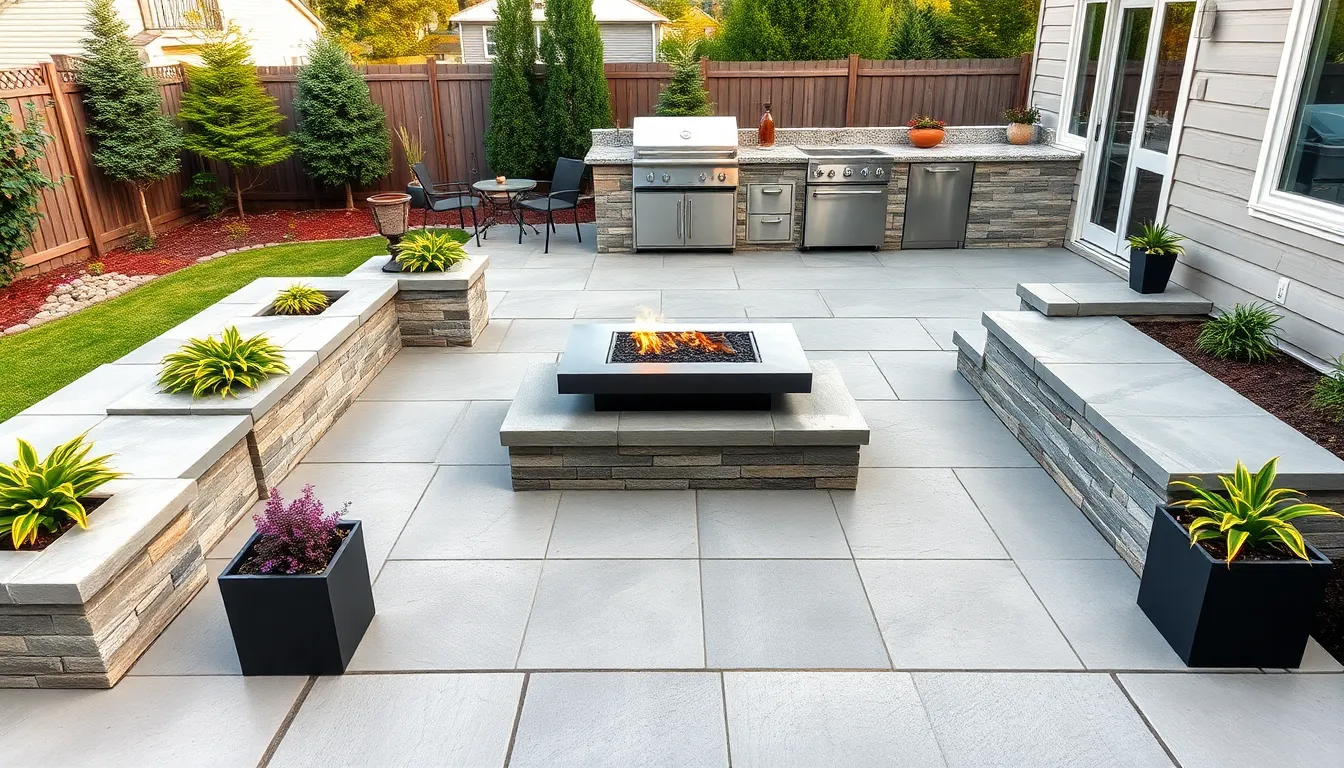
Transform your cement patio into a complete outdoor living space by incorporating functional features that enhance both usability and aesthetic appeal. We’ll explore how built-in elements can maximize your backyard’s potential while maintaining the durability and versatility that makes concrete patios so popular.
Built-In Seating and Planters
Built-in concrete benches create stable, permanent seating answers that eliminate the need for additional outdoor furniture while helping define your patio’s layout. We can design these seating areas to follow your patio’s perimeter or create intimate conversation zones throughout the space.
Integrated concrete planters soften hardscape edges by introducing greenery directly into your patio design. We recommend positioning these planters along borders or incorporating them into seating walls to create a seamless blend between hard surfaces and natural elements.
Customization options for built-in features include decorative staining and textured finishes that complement your overall patio design. We can match these elements to your existing concrete work or create contrasting accents that add visual interest to your outdoor space.
Fire Pit Integration Options
Fire pits serve as natural focal points that draw people together while providing warmth and ambiance for evening gatherings. We can seamlessly integrate these features into your concrete patio design using matching materials and finishes.
Design variations range from simple circular pits to elaborate built-in fire features with surrounding seating areas that encourage social interaction. We often recommend incorporating fire-resistant materials and proper ventilation to ensure safety and longevity.
Concrete stamping and staining techniques complement fire pit areas by adding texture and color that match your desired aesthetic, whether you prefer rustic charm or modern sophistication. We can create defined zones around fire features using different concrete finishes to establish clear functional areas.
Outdoor Kitchen Concrete Foundations
Concrete patios provide excellent foundations for outdoor kitchens due to their superior strength and ability to support heavy appliances and countertops. We design these slabs with custom shapes and sizes that accommodate your exact kitchen layout requirements.
Zoned kitchen areas can be integrated directly into your patio design with designated spaces for food preparation, cooking, and dining that flow naturally together. We recommend creating level changes or decorative borders to define each functional zone while maintaining visual cohesion.
Heavy appliance support requires proper concrete thickness and reinforcement to handle the weight of grills, refrigerators, and stone countertops without settling or cracking. We ensure your outdoor kitchen foundation meets structural requirements while seamlessly blending with your existing patio design.
Budget-Friendly DIY Concrete Patio Ideas
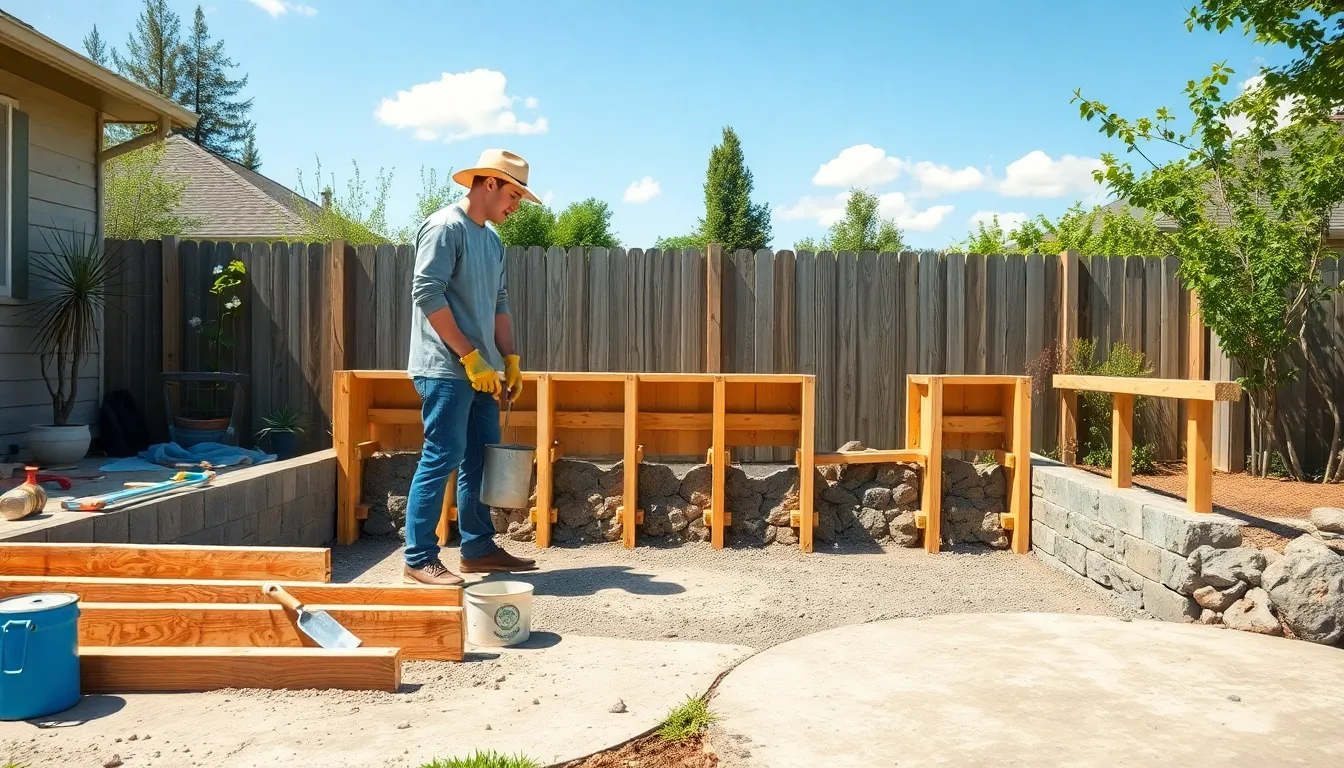
Creating stunning backyard cement patios doesn’t require very costly when you embrace DIY approaches. We can achieve professional-looking results using strategic techniques and affordable materials that deliver both durability and visual appeal.
Basic Poured Concrete Techniques
Preparing your foundation starts with proper ground grading and a compacted gravel base that ensures excellent drainage and structural stability. We recommend excavating to the appropriate depth and creating a level surface that prevents future settling issues.
Setting wooden forms shapes your concrete slab with either straight edges for clean modern lines or curved borders for softer organic designs. These temporary barriers guide your concrete placement and create the exact dimensions you envision for your outdoor space.
Pouring concrete evenly across the prepared area prevents air pockets that can weaken your finished patio surface. We suggest working systematically from one end to another while maintaining consistent thickness throughout the entire slab.
Leveling the fresh concrete with a screed board removes excess material and creates uniform thickness across your patio area. Following this step with careful troweling produces the smooth surface foundation that supports all decorative finishing techniques.
Allowing proper curing time with moisture retention methods develops the concrete’s full strength potential over several days. We cover fresh concrete with plastic sheeting or apply curing compounds that prevent rapid moisture loss and cracking.
Stenciled Pattern Applications
Applying concrete stencils transforms plain surfaces into decorative masterpieces that mimic expensive materials like natural stone or intricate tile work. We can use these tools on fresh concrete during the finishing process or on existing cured surfaces with overlay applications.
Combining concrete stain with stencil patterns creates rich color variations that enhance the realistic appearance of your chosen design motifs. These affordable coloring agents penetrate the surface and provide long-lasting hues that won’t peel or fade over time.
Selecting geometric patterns offers modern sophistication while floral designs add organic charm to traditional backyard settings. We find that vintage tile patterns work particularly well for creating distinct zones that separate dining areas from lounging spaces.
Creating visual texture through strategic stencil placement adds depth and interest without the expense of premium hardscape materials. Multiple pattern overlays can produce complex designs that rival professionally installed decorative surfaces.
Cost-Effective Finishing Methods
Staining concrete surfaces allows extensive customization with rich earth tones or bold accent colors that cost significantly less than natural stone or brick alternatives. We achieve these vibrant results using acid-based stains that react chemically with concrete minerals.
Exposing aggregate finishes reveals natural pebbles and stones embedded in the concrete surface while providing excellent slip resistance for safety. This textured approach creates visual appeal and durability that withstands heavy foot traffic and weather exposure.
Adding simple broom finishes increases surface texture and improves slip resistance with minimal additional cost beyond basic labor time. We drag stiff bristles across slightly set concrete to create consistent linear patterns that enhance both safety and aesthetics.
Integrating functional elements like built-in benches, fire pit surrounds, or planter borders during the concrete pour maximizes your investment value. These permanent features eliminate the need for separate purchases while creating cohesive design themes throughout your outdoor living space.
Combining multiple finishing techniques within a single patio design creates custom looks that reflect personal style preferences without expensive material upgrades. We often blend smooth areas with textured zones or incorporate colored borders that define different functional spaces.
Maintenance and Longevity Tips for Concrete Patios
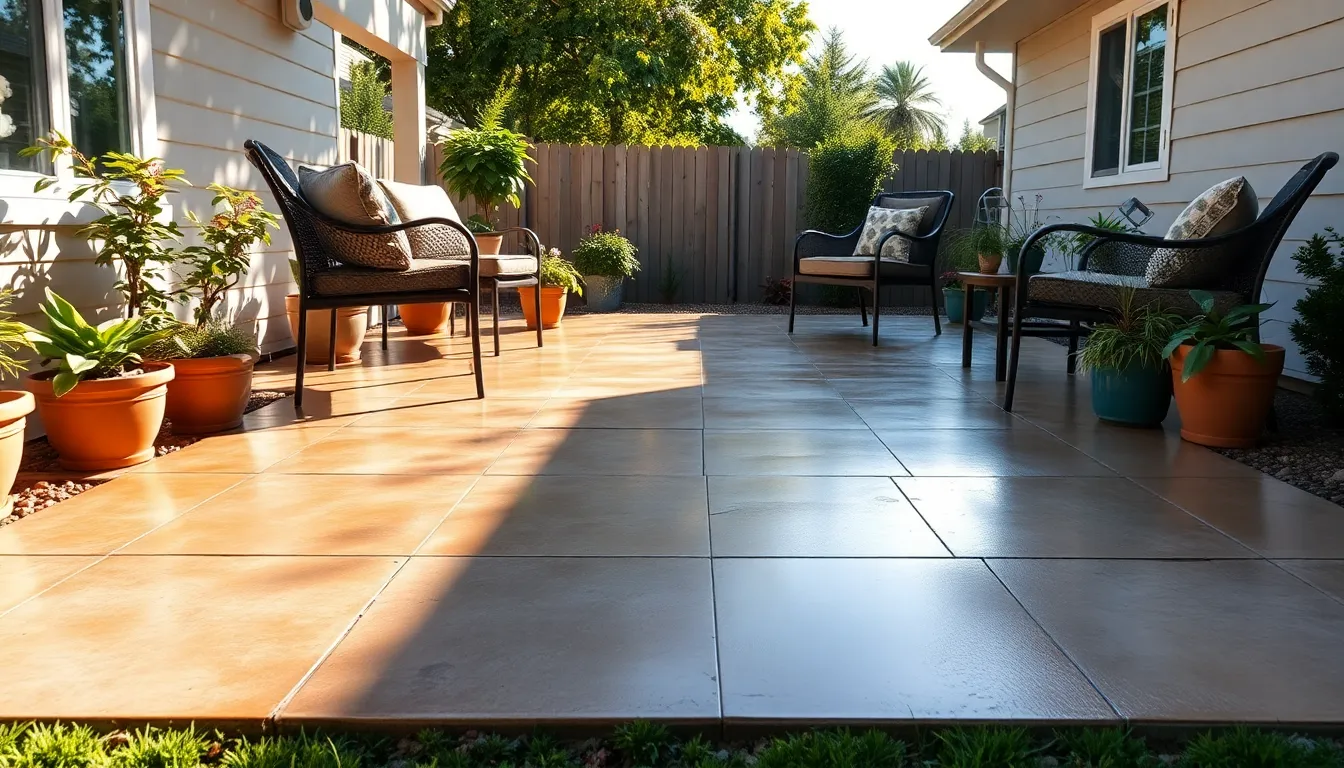
Investing in proper maintenance ensures your concrete patio remains beautiful and functional for decades. Strategic care techniques protect your investment while preserving the aesthetic appeal you’ve worked to create.
Proper Sealing Techniques
Sealing your concrete patio acts as the first line of defense against moisture damage, stains, and freeze-thaw cycles that can compromise structural integrity. We recommend using high-quality penetrating concrete sealers specifically designed for outdoor applications, as these products provide superior protection compared to surface-level alternatives.
Application timing proves critical for optimal results. Apply sealer only after your concrete has fully cured, which typically requires 28 days from the initial pour. This waiting period allows the concrete to reach maximum strength and porosity levels that ensure proper sealer penetration.
Reapplication schedules vary based on climate conditions and foot traffic, but most manufacturers recommend resealing every 2-3 years. Areas with harsh winters or heavy use may require more frequent applications to maintain protection. Test water absorption by sprinkling droplets on the surface – if water beads up, your sealer remains effective.
Coverage techniques ensure even protection across your entire patio surface. Use a low-pressure sprayer or roller to apply sealer in thin, consistent coats. Work in manageable sections to prevent lap marks, and avoid applying sealer during direct sunlight or extreme temperatures.
Cleaning and Stain Prevention
Regular cleaning routines extend your patio’s lifespan while maintaining its visual appeal throughout seasonal changes. Simple maintenance steps prevent costly repairs and preserve the decorative finishes you’ve invested in creating.
Daily maintenance starts with frequent sweeping to remove dirt, leaves, and debris that can scratch surfaces or create staining when wet. Use a stiff-bristled broom to dislodge particles from textured surfaces, paying special attention to stamped patterns and exposed aggregate areas.
Periodic washing with mild detergent and water removes accumulated grime and prevents permanent discoloration. Mix gentle dish soap with warm water, scrub with a soft brush, and rinse thoroughly with clean water. Avoid harsh chemicals, bleach, or acidic cleaners that can damage concrete surfaces and compromise sealer effectiveness.
Immediate spill response prevents permanent staining from oil, grease, food, and beverages. Blot liquids immediately with absorbent materials, then clean with appropriate answers. For oil stains, apply dish soap directly to the area and scrub gently before rinsing.
Protective measures include using furniture pads under heavy items, placing mats in high-traffic areas, and positioning planters on saucers to prevent water rings. These simple steps minimize surface wear and maintain your patio’s original appearance.
Repair Answers for Common Issues
Early intervention prevents minor concrete issues from developing into major structural problems that require expensive replacement. Understanding repair techniques helps you maintain your patio’s integrity while preserving its aesthetic value.
Crack repair addresses the most common concrete patio issue before water infiltration causes expansion and worsening damage. Small hairline cracks can be filled using concrete crack fillers or flexible sealants designed for outdoor use. Clean the crack thoroughly, apply filler according to manufacturer instructions, and smooth the surface for seamless integration.
Resurfacing answers restore patios with multiple small cracks or surface deterioration without complete replacement. Concrete resurfacing products create thin overlays that bond to existing surfaces, providing fresh appearance and renewed protection. This approach costs significantly less than full replacement while extending patio life by years.
Paver replacement offers targeted answers for individual damaged sections in paver-style installations. Remove damaged pavers carefully, level the sand base, and install matching replacements. This selective approach maintains overall patio integrity while addressing exact problem areas.
Surface restoration techniques address discoloration, scaling, and minor damage through professional refinishing methods. Options include acid etching, grinding, and applying decorative overlays that restore original appearance while adding new protective layers.
Conclusion
We’ve shown you that concrete patios offer endless possibilities for creating stunning outdoor spaces that reflect your personal style. From stamped patterns and decorative stains to integrated features and budget-friendly DIY approaches there’s a solution for every homeowner and budget.
Your backyard cement patio doesn’t have to be ordinary. With the right design choices finishing techniques and maintenance practices you’ll create an outdoor entertainment area that adds value to your home while providing years of enjoyment.
We encourage you to start planning your concrete patio project today. Whether you’re working with a small space or designing an elaborate multi-level system the durability and versatility of concrete make it the perfect foundation for your outdoor oasis.
Frequently Asked Questions
What are the main advantages of choosing concrete for patio construction?
Concrete patios offer exceptional durability, low maintenance requirements, and versatility in design options. They can mimic expensive materials like natural stone or wood through stamped patterns and decorative finishes while remaining cost-effective. Concrete also provides excellent weather resistance and can be customized with various colors, textures, and patterns to match any outdoor aesthetic.
How much does a stamped concrete patio typically cost compared to natural materials?
Stamped concrete patios generally cost 50-70% less than natural stone or brick alternatives while providing similar visual appeal. The average cost ranges from $8-15 per square foot installed, compared to $15-30 per square foot for natural materials. This significant cost savings makes stamped concrete an attractive option for homeowners seeking premium aesthetics on a budget.
What maintenance is required for concrete patios?
Concrete patios require minimal maintenance when properly sealed. Regular cleaning with mild soap and water, immediate spill cleanup, and resealing every 2-3 years will preserve their appearance and longevity. Avoid harsh chemicals and deicing salts, and address any cracks promptly to prevent water damage and further deterioration.
Can I install a concrete patio myself, or do I need professional help?
Basic concrete patios can be DIY projects for experienced homeowners with proper tools and preparation. However, decorative finishes like stamping, intricate patterns, or large areas typically require professional installation to ensure proper technique and durability. Consider your skill level, available time, and desired complexity when deciding between DIY and professional installation.
How long does a concrete patio last?
A properly installed and maintained concrete patio can last 25-30 years or more. Factors affecting longevity include climate conditions, soil stability, installation quality, and maintenance practices. Regular sealing and prompt repairs help maximize the patio’s lifespan, while proper drainage and foundation preparation are crucial for long-term durability.
What design options are available for concrete patios?
Concrete patios offer extensive design flexibility including stamped patterns (wood, stone, brick), decorative stains and dyes, exposed aggregate finishes, geometric patterns, and textured surfaces. Color options range from natural earth tones to bold accents, and features like integrated seating, planters, and fire pits can be incorporated during installation.
How do I prevent cracks in my concrete patio?
Prevent cracks by ensuring proper ground preparation, adequate thickness (typically 4-6 inches), proper reinforcement with rebar or wire mesh, and appropriate expansion joints. Proper curing, avoiding heavy loads during the initial curing period, and maintaining good drainage around the patio also help prevent cracking issues.
When is the best time to seal a concrete patio?
New concrete should be sealed 28 days after installation to allow complete curing. Existing patios should be resealed every 2-3 years or when water no longer beads on the surface. Apply sealers during mild weather conditions (50-80°F) with low humidity and no rain expected for 24-48 hours after application.

